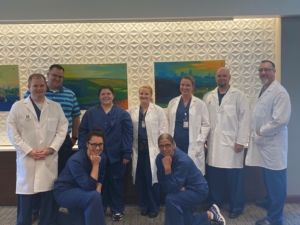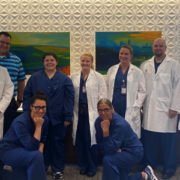MTN Tissue Services

Some of MTN’s newest Tissue Services staff members with our Wednesday – Friday team
Most people are familiar with organ donation, yet many know less about tissue donation and transplantation. The life-enhancing — and sometimes lifesaving — gift of tissue donation can help grateful recipients heal from painful injuries, return to active lifestyles and more. We asked our Tissue Services Manager, Jeff Allison, CTBS, and Director of Tissue Services, Melissa Williams, MSW, CEBT, CTBS, to answer these questions to share the importance of this less commonly known type of donation.
Briefly describe types of donatable tissue and common uses associated with them.
We recover dermis, bone, veins, tendons, heart valves, pericardium and ocular tissue.
- Dermis is used in skin grafts for burn victims, in dental surgeries, and for breast reconstruction post-mastectomy.
- Bone can be used in many forms for replacement post-tumor resection, in spinal surgeries and to aid in the healing of complex fractures.
- Saphenous veins and femoral veins are used for various types of vascular surgeries.
- Aortoiliac arteries are used to replace infected synthetic grafts or to replace damaged aortoiliac arteries.
- Tendons are used for various sports medicine and orthopedic surgeries.
- Heart valves are used to replace infected or malfunctioning valves.
- Corneas are used to replace damaged or diseased corneas.
- Pericardium is used for scrotal surgeries.
What impact can a tissue transplant have on an individual? Can tissue transplants be lifesaving?
While tissue transplants are not usually seen as lifesaving, there are two tissues that MTN recovers that could be considered lifesaving: heart valves and aortoiliac arteries. While most tissue transplants are considered life-enhancing, most transplant patients see them as providing a new outlook on life.
What are the most common types of tissues recipients need?
- Tendons
- Bone
- Dermis
- Corneas
- Heart valves
What is one misconception about tissue donation that you would like to address?
Many people think that if you are older or have cancer or diabetes, you can’t be a donor. We have a questionnaire that the family answers, and those answers determine if the patient will be or not be a donor. You can donate tissue up to age 100. Even those with cancer and diabetes can donate some tissues.
What is the one thing you’d want to tell someone who knows nothing about your work?
This job is very rewarding. It is very nice to see the letters that donor families and recipients exchange about the donor and the new life the recipient received.
What are some typical degrees and/or career paths staff members pursue before joining the Tissue Services department?
- Surgical technician
- Embalmer
- Paramedic
- Biology degree
At a high level, describe how tissue donation/transplantation varies from organ donation/transplantation.
Tissue donors have had a medical event that has caused their hearts to stop working; they have been pronounced cardiac deceased by a medical professional. Tissue recovery takes place up to 24 hours after cardiac death, whereas an organ donor must be hospitalized on ventilator and at or near brain death. During an organ recovery, a medical professional (surgeon or a highly trained preservationist) recovers the organs that have to be transplanted as quickly as six hours and as long as 24 hours after recovery. Tissue can be preserved for up to five years before being transplanted. Organ transplants save lives, and tissue transplants typically are life-enhancing.
Why should people say “yes” to tissue donation?
People should say “yes” to tissue donation because there is a great need for all tissue that we can recover, and by becoming a tissue donor, you can help on average 100 people have improved quality of life in your death.







